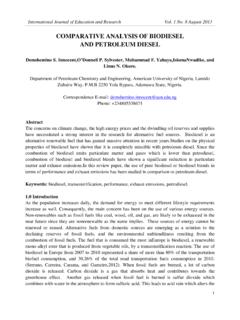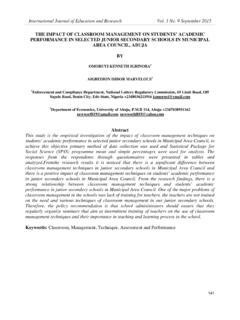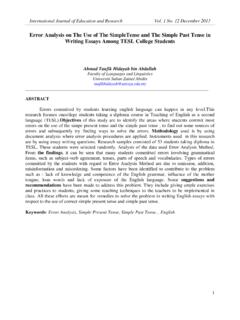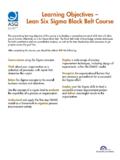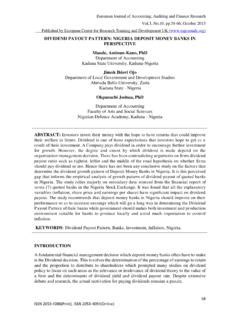Transcription of Comparative Analysis between System Approach, …
1 International Journal of Education and Research Vol. 3 No. 12 December 2015 261 Comparative Analysis between System Approach, Kemp, and ASSURE Instructional Design Models By Ahmad Abdullahi Ibrahim Department of Arts and Social Sciences Education Northwest University, Kano ABSTRACT Nowadays, teachers face a lot of challenges of their being held accountable for their students academic achievement and the existing chances to teach beyond traditional methods through the use of innovative instructional technology and media. However, Instructional Design Models help teachers to provide systematic way or approach for effective utilization and implementation of educational media and technology in teaching.
2 Therefore, this paper gives an overview of three Instructional Design Models ( System Approach, Kemp, and ASSURE Instructional Design Models) followed by comparison and contrasting differences between the models. So, it might be helpful for teachers to select more appropriate model for integrating technological gadgets into their teaching. INTRODUCTION Instructional design is defined as the systematic way of or process of transmitting general principles of learning and instruction into plan for instructional materials and learning (Branch, 1998). However, model could be defined as a way of doing something; an explicit presentation of a reality, it is an example or pattern that prescribes relationship in a normative sense (Branch, 1998).
3 Thus, Instructional design models give structure and meaning to a problem, giving chance to a designer to negotiate the design task by using a process or systematic method (Fauser, Henry, & Norman, 2006). Andrews and Goodson (1980) stated that instructional design models serve three purposes; i. Improving learning and instruction by means of the problem solving and feedback characteristics of the systematic approach. ii. Improving management of instructional design and development by means of the monitoring and control function of the systematic approach. iii. Improving evaluation process by means of the design components and sequence of events, including the feedback and revision of events.
4 There are many instructional design models initiated by scholars of Instructional Technology such as System Approach model byDick & Cary, Kemp Modelby Kemp, Smellie and Szumski,ASSURE model by Smaldino,and many others. In this paper the above mentioned three instructional design models have been selected forcomparison. ISSN: 2411-5681 262 System APPROACH INSTRUCTIONAL DESIGN model System approach model is among the most influential ID models. It is like many other ID models as it involved with the core elements of Analysis , design, development, implementation, and evaluation (Dick& Cary, 2005).
5 System approach model is not only based on theory and research. But it is also based on a considerable amount of practical experiences in its application. The System approach model is more complicated than others some times, because its approaches were based from the five core elements which were broken down into more various steps with different terminologies (Brach &Gastefon, 2002). Components of System Approach Instructional Design model and Their Inter Dependency This model consists of ten inter-dependent components in procedural or sequential steps. Each component depends on another one as shown by the black arrow lines.
6 The components or boxes represent theories, procedures, and techniques employed by the instructional designer to design, to develop, to evaluate and to revise instruction. While the white arrows of the figure represents formative evaluation points and instructional revision, which originate from reexamination of the instructional Analysis s validity and entry behavior of learners. Figure Illustration of the Components of System Approach model and Their Inter Relationship Dick and Carry, (2005) The components of the model are (a) assess needs to help identify learning goals, (b) conduct instructional Analysis (c) analyze learners and contexts, (d) write performance objectives, (e) develop assessment instrument, (f) develop instructional strategies, (g) develop and select instructional materials, (h) design and conduct formative evaluation, (i) revise instructional base from formative evaluation, and (g) design and conduct summative evaluation (Dick & Cary, 2005).
7 IdentifyInstructional Goal: this is the first component of the model , which means determining what the instructor expects from the learners to be able to do after the instruction. The instructional goal can be derived from various ways; it can be derived from a list of goals, from a need assessment, from practical experience with students learning difficulties, and from Analysis of people where they are doing a job, or from other sources for new instruction (Dick & Cary, 2005). International Journal of Education and Research Vol. 3 No. 12 December 2015 263 Conduct Instructional Analysis : this refers to a procedure applied by the instructor to identify the level of audience s skills, knowledge, attitudes toward the new instruction he is going to conduct.
8 Therefore, the instructor must carefully examine and create step by step task description to help learners achieve instructional goals (Dick & Cary, 2005). Analyze Learners and Contexts:these components deals with the process of instructional Analysis , including the process of collecting information from the learners, concerning their entry behavior, characteristics, prior knowledge, skills and attitudes, academic motivation and learning preferences. On the other hand, the Analysis of the learning context determines what is and what should be. What is refers to a review of the setting in which the instruction will take place, while what should be is facilities, equipment, and resources that adequately support the intended instruction (Dick &Carry, 2005).
9 Therefore, the instructor should select appropriate environment that can support teaching and learning processby considering the following elements: 1. The compatibility of the site with instructional requirements 2. Adaptability of the site for stimulating aspects of the work place or performance site 3. The adaptability of the site for using a variety of instructional strategies and training delivery approaches and 4. The constraints present that may affect the design and delivery of the instruction. Write Performance Objective:the aim of this is translating the needs and goals into specific objective, by writing precise statement of what the learners will be able to do after the completion of the instruction (Dick & Cary, 2005).
10 A well stated instruction objective must fulfill either one or all of the following components: 1- Performance: what students will do to indicate that they have learned 2- Condition: the circumstance under which the students are expected to perform 3- Criteria: the standard that design the acceptable performance Develop Assessment Instrument:the purpose of this is to measure the performance objectives of the learners. Knowing the behavior of each objective, condition, and criteria gives guidance to designer on knowing how to select and determine an assessment instrument that can measure performance objectives. Both objective and assessment are dependent on each other (Dick & Cary, 2005).
